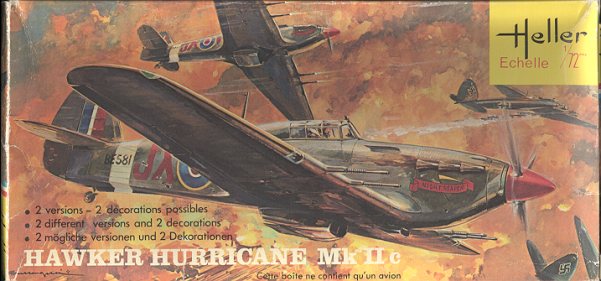
|
KIT: |
Heller 1/72 Hurricane IIc |
|
KIT # |
152 |
|
PRICE: |
$? |
|
DECALS: |
Two aircraft |
|
REVIEW & |
|
|
NOTES: |
|

|
HISTORY |
The Hurricane IIc was the aircraft that was originally designed back in the mid 1930s. This variant had the machine guns replaced with four 20mm cannon. These aircraft entered service in June of 1941, but by the end of the year, many had been superceded in many home squadrons by Spitfires and other types. However, they proved to be the perfect ground attack aircraft in North Africa where the power of the four 20mm guns was particularly effective against soft targets like troops and trucks. The type was also used in the Far East where it in continual use against the Japanese in India and Burma until the end of the war. Though not the fastest or most maneuverable, it was a rugged airframe that gave good service.
|
THE KIT |

Though there is no date on the box or instructions, I can tell you that this kit has been around since the early 1970's as this is the first boxing of the kit. Heller used a rather flimsy box at this time which was, thankfully, replaced by a much more sturdy version in the mid 1980s. The kit is much more detailed than the Airfix kit of similar vintage in that it has a floor, seat, control stick, gun sight and instrument panel for the cockpit, something missing in the simpler Airfix kit. The under fuselage radiator housing is also closer to prototypical and it has separate gear doors and struts. The kit also has fully enclosed main gear wells, an optional Aboukir sand filter and a boarding step. The windscreen and canopy are separate items so it can be displayed open to show of any work done on the interior. There are also flame shields provided, but not all Mk. IIc Hurricanes used them. Check your references.
Though of the raised panel line vintage, the overall external detailing is
very nicely done and no where near as heavy-handed as on similar kits of this
age. It is even better in some respects than the more modern Hasegawa and Revell
of Germany issues, especially in the way the fabric portions of the airframe are
depicted. The only negative comment I can make on the kit is that the gear doors
have some sink marks on them due to the thickness of the plastic.
Instructions are standard Heller of the time with a single exploded view showing parts placement. It is in French with English and German translations on the back of the sheet. Heller paint numbers are given. Two very small paint and decal diagrams are given. The sheet itself is very matte and despite its age, is not that badly yellowed. Two aircraft are given. One is the box art plane from 253 Sq RAF in overall black (yes, I know that the box art shows the plane in greens and greys). The other scheme is for a SEAC Hurricane of 1 Sq Indian AF in greens and greys with white bands on the fuselage and tail sections. These will have to be painted on. As with other common planes, there are a large number of aftermarket sheets that one can use on this kit.
|
CONCLUSIONS |
I'd have to rate this kit rather highly in my list of 1/72 Hurricane kits. It doesn't have some of the amenities of more modern Hurricane kits like those from Hasegawa, Revell of Germany or Academy (who based their kit on this one, I believe). However, it has enough detail for just about anyone but the most fastidious, and is a lot less expensive than the others, often being found for $5 or less at swap meets. I can recommend this kit to anyone who has an interest in the type.
Review kit courtesy of me and my wallet!
If you would like your product reviewed fairly and quickly by a site that has thousands of visits a day, please contact me or see other details in the Note to Contributors.